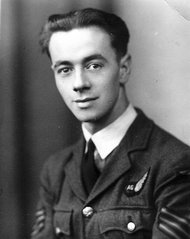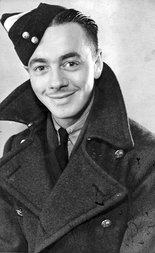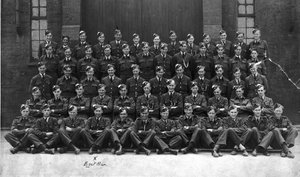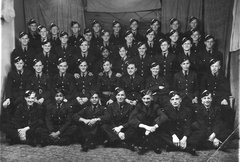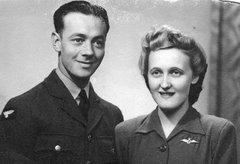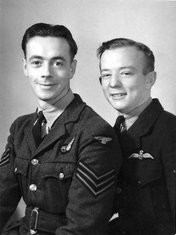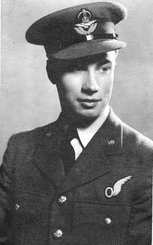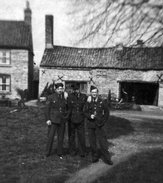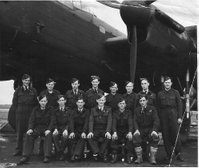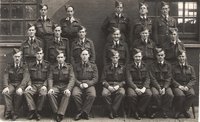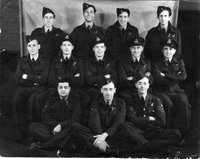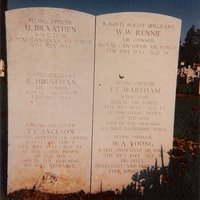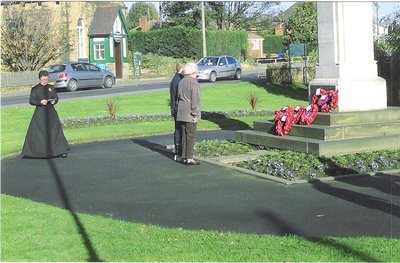Lancaster ME699 - A Bomber crew at war
Warrant Officer Bob Routledge, RAF
In September 2005 I got an email out of the blue from a Janet Spencer saying "My Dad is in the photograph", and that was it. Anyone looking at this site will realise that this was not the most useful start to what has been the most amazing revelation of this story so far.
After a couple of exchanges I managed to work out that what Janet was telling me. Her Father, Bob Routledge, was in the picture of the crew of KM-T with my Father. This was completely out of the blue, as the name had not come up from any other route of research to that point as pretty much all the records available deal with the casualties, POWs and evaders, not the men that survived unscathed, physically at least.
After another email from Janet's sister Gillian we ended up having a long telephone conversation. Gillian explained that they had come across the site while looking for a 44 Squadron badge, unfortunately for their Father's gravestone, as he had died suddenly in the Summer. In 1944 Bob had been a regular member of Bill Young's crew. Bob would have been on board the aircraft on the night it was lost but had been taken ill just before take off and replaced at the last moment by "a young lad on his first mission".
Bob had been married at the time and his widow, Jennie was still alive and had known my father and the rest of the crew.
After exchanging many emails we finally met up in November 2005 and exchanged stories and photographs. Gillian also lent me her most treasured possession, her Father's Flying Log Book so that I could scan it for the site.
Many thanks to the Routledge's for all their help, especially the very special lady that was Jennie Routledge who wrote up Bob's story for me which is below..
Robert Stainsby Routledge
Bob was born 26th March 1922 at Smawthorne Grove, Castleford to Elsie (nee Woodhall) and John Stainsby Routledge. Bob had 2 elder brothers Harry who was in the RAF Military Police and Jack who was a peacetime soldier in the Coldstream Guards and was discharged from the Army following Dunkirk. He also had a younger sister Barbara who was in the ATS. Sadly all have passed away.
Bob came from a mining family and his Grandpa was the Manager at Glasshoughton Colliery and his Grandma a headmistress. Both came from Rye in the North East. Bob’s parents had a General Store in Smawthorne Grove but his father was a winder at the local colliery.
In 1935 the family sold the business and moved to Methley to be nearer for John who had transferred to Water Haigh Colliery at Oulton. For his last few years at school Bob attended Mickletown Council School and this is where we met. The playground was separated by a fence with girls at one side and the boys the other so we courted over the fence.
After Bob left school at the age of 14 he started work with Boots the Chemist in Leeds and was the delivery boy taking prescriptions on his bicycle to various Companies and Orphanages in the Leeds area. Due to the Trams, which ran back in 1930’s, he had plenty of grazed knees etc., having caught his bicycle wheels in the tram lines. On one occasion due to heavy fog Bob had to guide the bus from Leeds to Castleford by walking in front of it with his torch. From there Bob went to work for the Railways but still connected with the Mining Industry this work involved shunting coal from the Pit yard to the coal trucks. It was from here in 1942 that he volunteered and joined the RAF as an Air Gunner.
Bob joined the RAF on June the 3rd 1942 and his first posting was to Padgate as I recall. His next posting was to Blackpool for Square bashing as he called it. The cadets lived in Boarding Houses and were not allowed to visit the Tower and Pleasure beach etc., it was no holiday Bob told me. From here to various places until the beginning of 1943 when he was transferred to Bridlington. Bob and I married in our village chapel at Methley on the 29th May 1943 and coincidently went to Bridlington for a few days honeymoon courtesy of Grandpa Routledge who gave us £30. Imagine going on honeymoon with such a small amount.
After this things got very serious and Bob went to Gunnery training at Morpeth, Bawtry, Manby, Syston and Maltby (but not necessary in that order). He was crewed up with Bill Young at 82 OTU (Ossington, Lincolnshire) where the five (Bill Young, Frank Wareham, Jack Wainwright, Leslie Jackson and Bob) flew together in Wellingtons to learn their trade as a bomber crew.
From there the crew moved on to 1657 HCU (Stradishall) in February 1944 where the five man crew became seven flying in Stirlings with the addition of a mid-upper ginner (Bill Rennie) and a flight engineer (Bill Robinson). Lastly they moved to 5 LFS to convert to the Lancaster before being posted to 44 (Rhodesia) Squadron at Dunholme Lodge.
At the end of March 1944 I received a letter from Bob asking me to telephone him at the Sergeant's Mess the following day at an arranged time. At that time my maternal Grandfather was a Methodist minister, nearing the end of our brief telephone conversation Bob asked me to ask Granddad to say a prayer for him and the crew that evening. From that I knew something was going to happen – it was the raid on Nuremberg and 95 Aircraft were lost. Luckily KM-T was not one of them.
Operations
Mike takes up the story once more. Over the next three months the crew of KM-T flew together on a further nineteen missions as detailed in William Young's Crew story with Bob as rear gunner in each of the flights. After a few early close shaves the crew had a relatively straightforward time supporting the build up to D-Day in June 1944 and then taking part on Operation Crossbow against various V weapon targets.
Life for a bomber crew was very much one of eat, drink and be merry for tomorrow you may die (quite literally). Bob, as a married man, did his best to get home at every opportunity, but Bill Young's crew had its share of high jinks. Jennie recalls that my Father, then very much a single man, was "very dashing". Frank Wareham was also a very popular man it seems, despite being married!
The story behind Bob missing the fatal mission on the night of the 4th and 5th of July is that after briefings Bob was found to be running a very high temperature and was replaced at the last moment by Ronald Houseman and admitted to hospital.
The reason that Bob was ill was related by his daughter Gillian. It would seem Bob got ill after he and Leslie Jackson had spent a night in a Lincolnshire ditch after falling off bikes on their way back to Dunholme Lodge after a night out. A very typical Bomber Command story, and a night out that may well have saved Bob's life.
It would seem that Bob was originally assumed to be missing with the rest of Bill Young's crew and that a "Missing" telegram was prepared to send to Jennie and luckily stopped just in time. Indeed the 44 Squadron records still show as Bob being on the fateful flight (as documented at the "Houseman" family info site) and Bob's log book also carries an entry in another man's handwriting stating "Missing" as a result of ops on the 5th July, signed off by the 44 Squadron and B Flight Commanders before continuing with the rest of his tour of operations on the following page.
Below Jennie Routledge continues Bob's story after the loss of his crew mates. Very early in my research I was told what a huge hole was left in the lives of the odd survivor from a crew when the rest were killed. Certainly Bob seems to have felt all this, plus a degree of guilt for not being there to spot the Night Fighter that shot the aircraft down. At that point the crew would have been together almost constantly for ten months working as a team, fighting and living together. Suddenly, and devastatingly, Bob was all alone.
The rest of Bob's story
After the fatal night of 4th/5th July 1944 and following his stay in the Military Hospital Bob was sent home on compassionate leave. At the time he was unaware that Jack Wainwright and Bill Robinson had survived the crash. It is very difficult to say how this affected Bob but although he never said much about the subject he did always state that it would not have happened had he been on board with his extra experience.
Bob and I travelled to Hull to see Mr & Mrs Jackson the parents of Leslie Jackson who was their only child. Like wise Bill Young too was an only child and Bob wrote to his parents in Broken Hill, NSW, Australia. After the war Mr & Mrs Young asked us to consider immigrating to Australia and they would help us to make a new start near them. This was a very generous and kind gesture but because of our family commitments we declined.
Bob returned to Dunholme Lodge and completed his tour of operations with two other crews, flying three times with Flying Officer Boswell as mid-upper gunner and then eleven times with F/O Davey as rear gunner.
Bob became a Warrant Officer about this time and also a Rear Gunner Instructor. At the beginning of 1945 he was posted to the Isle of Man to RAF Andreas - Satellite Airfield to Jurby, once more as an instructor. In the March of 1945 I was released from war work and joined Bob in the Isle of Man. We rented 2 rooms from Sally Stothard who worked in the Village Shop/Tea rooms. Her husband was also in the RAF and was stationed abroad. They had two children Rona and Pearson. Rona went daily to the village school but Pearson only on the days there was a space for him if someone was absent.
There was a Cinema at Jurby and Bob and I used to cycle over occasionally. Bob had a RAF bicycle and my Dad shipped mine over. We were sat in the cinema one evening and just before the lights went out Bob said "My God Jennie there’s Jack Wainwright." We just could not believe our eyes having thought he had perished in July the previous year. There he was, Bob’s pal. What a reunion that was!
Jack told Bob two of them had managed to bail out himself and Bill Robinson and both of them got back to UK safely. Bob and Jack met the following Saturday in Ramsey and Jack told him the story of their brave and lucky escape.
VE Day and beyond
The day peace was declared was Bob's day off and although we knew the end was in sight it still came as a surprise. We managed to muster together one shilling and we cycled to the Grosvenor, the only pub in the village, to find everyone celebrating. With our shilling we managed two drinks each. Two Red Label at threepence halfpenny (about 1p today) each and 2 Blue label at threepence halfpenny (about 1.5p today) each. In the August Bob was posted to Phwelli in Wales and I went balk to my parents in Methley.
Bob was demobbed on New Years Day 1946 and spent the night in the RAF canteen in London. He was released on Class B due to his employment with the Railways. He arrived home with his demobbed kit – Grey & White stripped suit, green shirt, fawn raincoat and a green trilby - he kept the trilby on for days. He started back at the Prince of Wales Colliery Pontefract and stayed for 6 months, which was a condition of Class B release after that period, he joined his father at Water Haigh Colliery, Oulton . Bob went to night school and obtained both his Deputy’s and Overman’s papers. He was also a member of the miners rescue team and was called upon to go to other Collieries if/when disaster struck. Bob stayed with British Coal until his retirement in 1982.
In 1972 we had the opportunity to visit the Marissel French National Cemetery and sought out the Communal grave Number 284 of KM-T crew – it was a very touching moment for all of us.
Bob and I enjoyed a long and happy retirement celebrating our Diamond Wedding with a home visit from the Lord Mayor of Leeds, a Greeting card from HM the Queen and a family holiday in Benidorm.
Bob died on the 10th June 2005 leaving Jennie his wife, two daughters Janet & Gillian, son in law Michael and three grandsons Jonathan, Matthew and Thomas.
It was a Bob's request donations were made to the 44 (Rhodesia) Squadron Association. This donation will be used by the Squadron as an annual award at the William Farr School, which was built on the airfield at Dunholme Lodge. It will be in memory of RS Routledge Rear Air Gunner.
My family and I would like to give our eternal thanks to James and Mike Wainwright without whom none of this would have been possible.
Jennie Routledge (December 2005)
Unfortunately Jennie Routledge passed away on the 9th May 2007. She is sadly missed but is now reunited with her Bob. Rest in peace Jennie.






































